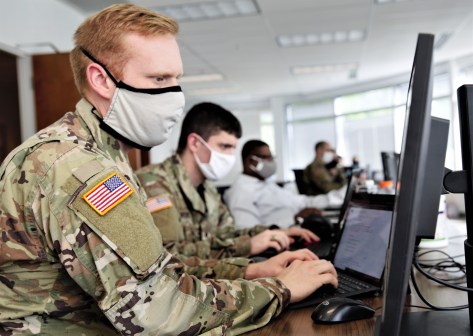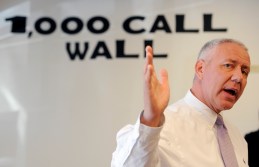Inside the Pentagon’s new cyber strategy
The Defense Department unveiled a broad new cyber strategy Thursday that calls for sweeping changes to the department’s relationship with the tech industry, including the formation of an experimental innovation unit based in Silicon Valley, a new military branch of the U.S. Digital Service, investments for tech startups and a revamped industry fellowship program for military officers.
Secretary of Defense Ash Carter laid out the details of the new strategy in a speech Thursday at Stanford University. He is the first sitting Defense secretary to visit Silicon Valley in nearly 20 years. After his speech at Stanford, Carter paid a visit to Facebook’s headquarters in Menlo Park, where he met with Chief Operating Officer Sheryl Sandberg and veterans who work at the company “to discuss what DOD can learn about Facebook’s innovative approaches to managing technical talent,” a senior Defense official said in a background briefing with reporters.
“The department must continue to pivot toward the commercial sector,” the official said. “While DOD laboratories, researchers and technologists remain world-class, much of the expertise necessary for generating breakthrough innovations now resides in the nondefense commercial sector. More and more of these technologies reside in small businesses and startups, not just blue chip corporate laboratories.”
During his speech, Carter emphasized the Defense Department’s role in helping fund and create some of the biggest technological developments of the last decade. “And most technologies used throughout Silicon Valley – including many that Apple brilliantly integrated into the iPhone – can be traced back to government or DoD research and expenditures,” Carter said. “The developers of multi-touch worked together through a fellowship funded by the National Science Foundation and the CIA. iOS’s Siri grew out of not only decades of DARPA-driven research on artificial intelligence and voice recognition, but also a specific project DARPA funded through SRI to help develop a virtual assistant for military personnel. And Google’s self-driving cars grew out of the DARPA Grand Challenge.”

The Pentagon’s plan for its Cyber Mission Force, as outlined in its new Cyber Strategy. (Department of Defense)
New units
In a speech titled “Rewiring the Pentagon: Charting a New Path on Innovation and Cybersecurity,” Carter plans to announce the formation of a new unit based in Silicon Valley designed to improve the Pentagon’s interaction with nondefense tech companies. The so-called Defense Innovation Unit Experimental will mark the first time that DOD has established a full-time outreach presence in Silicon Valley. However, it will not be confined to only the Valley, but it will also engage other technology hotspots around the country, officials said.
The DIUX will be “staffed by an elite cadre of active duty and civilian personnel … and will also be complemented by reservists,” a senior Defense official said. “They will focus on scouting emerging and breakthrough technologies and building direct relationships to DOD.”
Carter will also announce the establishment of a Pentagon branch of the U.S. Digital Service. “Bringing the U.S. Digital Service to the Pentagon will help us surge on some of the most vexing problems and give DOD access to some of the best engineers in the world,” a DOD official said. This group will initially be focused on “one of the most challenging and urgent problem we face — working on more seamlessly transferring our troop electronic health records from DOD to the Department of Veterans Affairs.”
Carter will also announce the launch of a pilot program to enable the department to tap into the creativity of startup ventures and will also make “a small investment” in In-Q-Tel, a nonprofit tech startup initially funded by the CIA.
“We will identify promising technologies with defense applications that we traditionally have not developed access to and we will foster the development of emerging technologies that have the potential for creating long-term advantages to the DOD, possibly being game-changers,” the senior official told reporters.
“The Department of Defense must be open for business and open to business,” the official said.
Workforce
The new strategy also provides clear guidance on the Pentagon’s efforts to build what it calls its Cyber Mission Force — a planned force of 6,200 military, civilian and contractor personnel who will be assigned to 133 teams across the department.
The CMF concept began in 2012 and makes up the core of the U.S. Cyber Command. “We want to capitalize on the expertise that folks who are in the private sector, but still want to serve their country, have,” Eric Rosenbach, assistant secretary of Defense for homeland defense and global security, told a Senate subcommittee April 14.
Building a cadre of cyber experts is very important to the Defense secretary, Rosenbach told the panel. Since taking office, he said, one of Carter’s top priorities has been ensuring the Defense Department has new “tunnels” for talent to enter the department’s cyber community.
The strategy also breathes new life into the Secretary of Defense Corporate Fellows Program, which sends 15 to 20 military officers each year to top commercial firms to gain business experience. Under the revised two-year program, officers will get to work in the private sector for a year and then return to the Pentagon, where they “will be assigned to a part of DOD where they can implement relevant business practices learned in their experience with industry,” an official said.
“Secretary Carter wants to see greater exchanges between industry and government so that our service members can learn from industry,” the official said. Those officers selected for the fellows program will receive joint service credit toward promotion.






